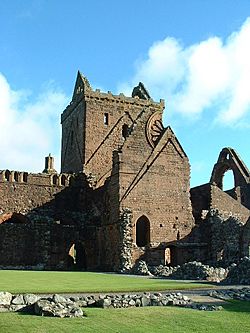Sweetheart Abbey facts for kids
| An Abaid Ur | |
 |
|
| Monastery information | |
|---|---|
| Full name | Abbey of Dulce Cor |
| Other names | New Abbey |
| Order | Cistercian |
| Established | 1273 |
| Disestablished | 1624 |
| Mother house | Dundrennan Abbey |
| Dedicated to | St Mary the Virgin |
| Diocese | Diocese of Galloway |
| Controlled churches | Buittle; Crossmichael; Kirkcolm; Kirkpatrick-Durham; Lochkindeloch; Wigtown |
| People | |
| Founder(s) | Dervorguilla of Galloway; Abbot Henry, S.O.Cist. |
| Architecture | |
| Style | Early English |
| Site | |
| Location | New Abbey, Dumfries and Galloway, Scotland, United Kingdom |
| Visible remains | Abbey church, precinct wall, chapter house |
Sweetheart Abbey, also known as the Abbey of Dulce Cor, was a Cistercian monastery founded in 1275. It is located in the village of New Abbey, in Dumfries and Galloway, Scotland. The abbey is about 8 miles (13 km) south of Dumfries.
Contents
The Abbey's Story
How Sweetheart Abbey Began
Sweetheart Abbey was founded by a powerful lady named Dervorguilla of Galloway. She built the abbey in memory of her husband, John de Balliol. After he passed away, Dervorguilla kept his heart with her in a special casket. She carried it everywhere until she died. When she was buried, his heart was buried with her.
Because of this deep love, she named the abbey Dulce Cor. This is Latin for "Sweet Heart." Their son, also named John, later became the King of Scotland.
The abbey was built from local red sandstone. It was designed in a style called Early English. This was a popular building style at the time. The first abbot, Henry, oversaw its construction. Sweetheart Abbey was a "daughter house" of Dundrennan Abbey. This meant it was a new monastery, which is why it became known as "New Abbey."
Life at the Abbey
The abbey grounds were very large, covering about 30 acres (120,000 m2). You can still see parts of the old wall today. The main church was dedicated to St Mary the Virgin. It was 203 feet (62 m) long, and its central tower reached 92 feet (28 m) high.
The Cistercian monks who lived here were called "White Monks." They wore white robes. Their lives were about prayer and quiet thinking. But they also played a big part in the local area. They were involved in farming and trade. This made the abbey a very important center for the community.
Challenges and Changes
Sweetheart Abbey faced tough times. During the First War of Scottish Independence, King Edward I of England even stayed there in 1300. After many years of fighting in the region, the abbey became quite damaged. It was described as being in "notorious poverty."
However, a nobleman named Archibald the Grim helped the abbey. He paid for many repairs and new buildings. Sadly, because of later damage, the graves of Dervorguilla and her husband were lost.
The abbey continued to operate for many years. But eventually, it was closed down during the Scottish Reformation.
The Abbey's Closure
After 1565, the Scottish Crown took control of the abbey. The last Cistercian abbot was Gilbert Broun. He tried to keep the Catholic faith alive, even after the Reformation. He was arrested in 1605 and sent away.
By 1624, the last of the monks had passed away. The abbey buildings and land were then given to Sir Robert Spottiswoode. He became known as the Lord of New Abbey.
King Charles I later wanted the abbey lands for a new church area. Sir Robert agreed, but he was never paid. The land was eventually returned to him. However, he was soon forced to leave the country, and the land went back to the Crown.
People Buried at Sweetheart Abbey
- John de Balliol and his wife Dervorguilla of Galloway (the founders)
- James Carruthers (1759–1832), a Catholic priest and historian
- Eric Drummond, 7th Earl of Perth (1876-1951)
- Hon. Angela Mary Constable-Maxwell (1877-1965), wife of the 7th Earl of Perth
- William Paterson (banker) (1658-1719), who founded the Bank of England
Sweetheart Abbey Today
The village next to the ruins is still called New Abbey. At one end of the main street is Monksmill, a corn mill. The current mill buildings are from the late 1700s. But there was an older mill built by the monks themselves. It helped the local farms.
The abbey ruins are a major landmark today. It's easy to imagine how important the abbey and its monks were in medieval times. They were skilled farmers and animal breeders. They helped shape the religious life and farming methods of the area.
A prayer book from the 14th century, called The Sweetheart Abbey Breviary, is now kept at the National Library of Scotland in Edinburgh.



